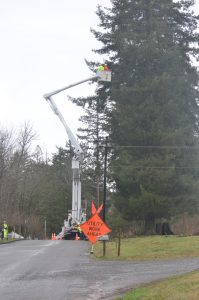 According to the Occupational Safety and Health Administration (OSHA), electrocutions are the third highest cause of construction worker deaths. Many electrical injuries and fatalities occur after a crane comes into contact with a powerline and the electrical current travels through the crane to the operator of the equipment. In order to help prevent these accidents from ever occurring, OSHA created extensive construction workplace safety rules for the operation of cranes and booms operating near powerlines. (29 C.F.R. 1926.1408).
According to the Occupational Safety and Health Administration (OSHA), electrocutions are the third highest cause of construction worker deaths. Many electrical injuries and fatalities occur after a crane comes into contact with a powerline and the electrical current travels through the crane to the operator of the equipment. In order to help prevent these accidents from ever occurring, OSHA created extensive construction workplace safety rules for the operation of cranes and booms operating near powerlines. (29 C.F.R. 1926.1408).
Under the OSHA regulation, before beginning equipment operations an employer must complete a number of steps. First, the employer must identify the work zone. The employer can either mark off the boundaries and prohibit equipment operators from going beyond the marked boundaries, or the employer can define the work zone as 360 degrees around the equipment up to the maximum working radius.
If any part of the construction equipment could get closer than 20 feet to a powerline within the identified work zone, the employer must take additional steps and complete one of the following options:
- Confirm with the utility company that the powerline has been deenergized and visibly grounded. The employer must assume that all powerlines are energized until confirmation from the utility company; or
- Ensure no part of the construction equipment could get within 20 feet of a powerline by implementing the precautionary measures listed below; or
- Determine the minimum approach distance of a powerline permitted under Table A and ensure that no part of the construction equipment could get closer than the minimum approach distance by implementing the precautionary measures listed below. Under Table A, the greater the voltage of the powerline the farther the minimum approach distance. The employer should contact the utility company to find out the voltage. Under OSHA, the utility owner must provide the requested voltage information within two days of the request.
All of the following precautionary measures must be taken in order to be compliant under option 2 or 3 above:
- The employer must conduct a meeting with the construction workers to review the steps that will be taken to prevent electrical accidents.
- If tag-lines are to going to be used, they must be non-conductive.
- The employer must erect and maintain an elevated warning line, barricade, or line of signs with flags or other high-visibility markings. The markings must be placed either 20 feet from the powerline or at the minimum approach distance under Table A. If the operator is unable to see the markings, the employer must use a dedicated spotter.
- The employer must implement one of the following measures: a proximity alarm, a dedicated spotter, a device that automatically warns the operator when to stop movement, a device that automatically limits range of movement, or an insulating link/device.
In addition to the above measures, the employer must train each operator and construction worker assigned to work with construction equipment. Among other training, workers must be informed what to do when there is electrical contact with a powerline and the safest means of evacuating from equipment that may be energized.
Kraft Davies Olsson represents construction workers that have been injured in electrical accidents. If you are a construction worker who suffered an crane-related electrical injury, you could be entitled to damages or compensation, especially if your employer violated OSHA regulations. Please call our experienced personal injury attorneys at 206-624-8844 or contact us through this website.
 Seattle Injury Lawyer Blog
Seattle Injury Lawyer Blog

